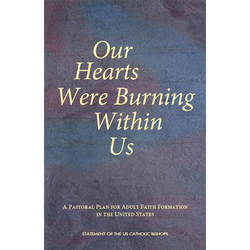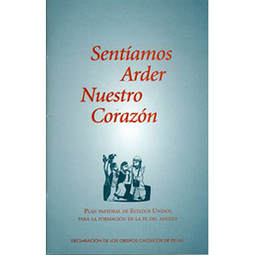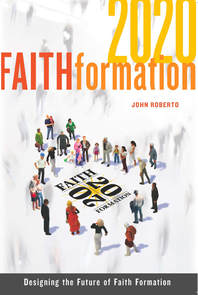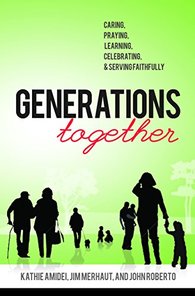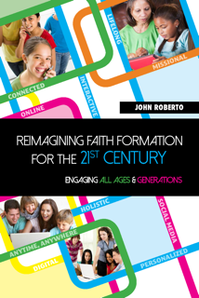Adult Faith Formation Toolkit
Design Process
1. Explore: An Introduction
|
Part 1. Explore: An Introduction

1. Three Goals of Adult Faith Formation, US Conference of Catholic Bishops, from their 1999 document, Our Hearts Were Burning within Us
2. Global Trends and Adult Trends Affecting the Future of Faith Formation - report from LifelongFaith.com
3. Adult Faith Formation Practices - from http://www.reimaginefaithformation.com/adults.html
From research studies, current thinking and practice in adult education and learning, and contemporary theory and practice in faith formation, we can identify eight features that provide the foundations upon which to build a twenty-first century approach to adult faith formation for all of the seasons of adulthood. (From Chapter One in The Seasons of Adult Faith Formation)
4. Toward Effective Adult Faith Formation: Top 10 Guidelines & Top 10 Pitfalls - Loyola Press
|
Part 2. Assess: Listen to Parishioners
Part 3. Plan
|
Option 1: SCENARIOS - At a symposium hosted by Lifelong Faith Associates in 2015, participants identified critical uncertainties facing our culture. From this list they narrowed their focus to two:
Uncertainty #1 The response of faith communities to the increasing diversity in society (economic, ethnic/cultural, households/families, sexual/gender, spiritual, religious). Responses can be arranged on a spectrum, where "faith communities resist diversity" is at one end and "faith communities embrace diversity" is at the other end. Uncertainty #2 The desire and interest of adults today in developing their spiritual life. The desire and interest can be placed on a spectrum with "decreasing desire and interest" on one end and "increasing desire and interest" on the other. When the two critical uncertainties are connected in a 2x2 matrix, a set of four stories—or scenarios— are created to describe how the future of adult faith formation could evolve. The scenarios express a range of possible futures and explain why the “main story” of adult faith formation will be framed by the response to these two significant uncertainties. The scenarios are not meant to be exhaustive or prescriptive—rather they are designed to be both plausible and challenging, to engage the imagination while also raising new questions about what the future of adult faith formation might look and feel like.
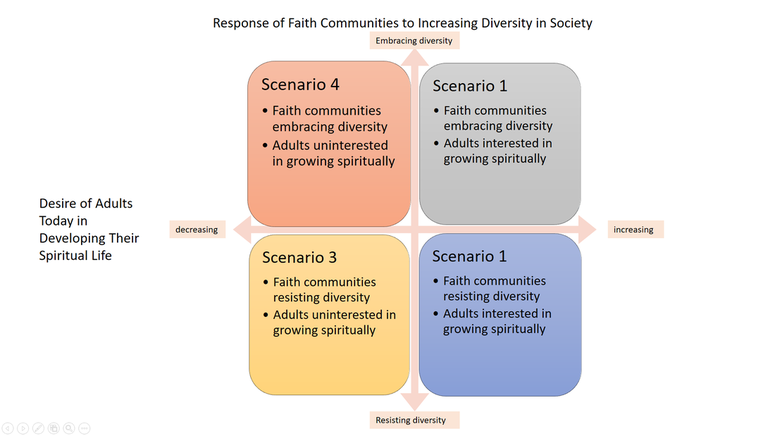 The Future of Adult Faith Formation, Lifelong Faith, Winter 2016, p. 7 The Future of Adult Faith Formation, Lifelong Faith, Winter 2016, p. 7
Option 2: SEASONS OF ADULT FAITH FORMATION - Adults have different needs, concerns and tasks that vary over the course of a lifetime. A parish can acknowledge these differing "seasons" by offering different faith development for each one. More people may participate because you are addressing areas of life relevant to them!
Option 3: PERSONALIZING FAITH FORMATION - Adults prefer to learn about what is important to them. The parish can help each person determine the direction of his/her faith development and support him/her along the journey.
Option 4: QUICK START - If you are eager to "Just do something already!" try one of these:
|
Part 4. Review: Resources for the Content of Parish Programs
- GEMS: Best Practices Mined and Shared - Sr. Janet Schaeffler OP curates a monthly newsletter with great suggestions for Adult Faith Formation.
- Ideas and Resources for Prayer - List of online resources compiled by Sr. Janet Schaeffler OP
- Online Resources for Adults to Use - Online resources to suggest to adults for their own use, compiled by Sr. Janet Schaeffler OP
- Online Resources on Catholicism and Catholic News - List compiled by Sr. Janet Schaeffler OP
- Media Resources for Adult Faith Formation - List of online resources to be used within parish programs, compiled by Sr. Janet Schaeffler OP
- Resources to Use within Adult Faith Formation - List of programs and websites that can provide content and method, compiled by Sr. Janet Schaeffler OP
- Strong Catholic Family Faith - This curated site is designed to assist parish and school catechetical leaders in supporting and resourcing families in their efforts to offer quality faith formation for children and families. Catechetical leaders can glean ideas from this site to supplement current activities or to suggest specific links to families.

- Echoes of Faith 3.0 - RCL Benzinger and the US National Conference for Catechetical Leadership have created this program to train catechists online in the content of the faith as well as how to teach, but anyone can use this program. (Think: easy, online mini-courses in the basics of the faith.) The modules are broken into 4 parts each, are both well-written and easy to understand and can be accessed on a smart phone.
- Albany Catholic Digital Library - provides links to high quality, reputable, mostly free resources which can be used for personal enrichment, in designing programming or adding content to parish faith formation and Catholic school websites for children, adolescents, adults and families.

- The Virtual Learning Community for Faith Formation - Adult faith formation anytime and anywhere via the internet. The goal is to support the church's professional ministry of religious education and faith formation in cyberspace. Topics span the gamut of Christian theology and spirituality. Individuals can take courses or your parish group can take a class together. Classes are usually 3-5 weeks long. Participants read materials on their own, post ideas related to what they have read on the course website and respond to each others' posts. A trained facilitator oversees the course. The VLCFF is coordinated and sponsored by the Institute for Pastoral Initiatives (IPI) at the University of Dayton, a Catholic Marianist Institution. The Diocese of Scranton is affiliated with the VLCFF so all Catholics within the diocese are eligible for reduced tuition.
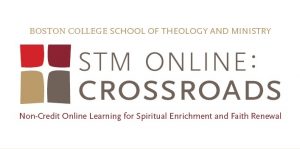
- Crossroads - a program of online continuing education courses on a wide range of popular, theological and spiritual topics through Boston College School of Theology and Ministry; functions similarly to the VLCFF.
Part 5. Dig Deeper: Additional Resources to Study This Topic
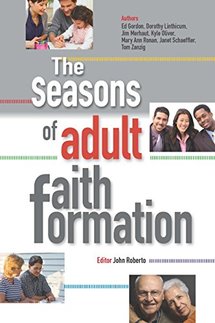
- Seasons of Adult Faith Formation - edited by John Roberto. Provides leaders with a deeper understanding of adulthood today, a vision of twenty-first century adult faith formation, and the tools and processes for designing faith formation for all the seasons of adulthood. The book’s chapters include:
- Faith Formation for All the Seasons of Adulthood—John Roberto
- The Development of Modern Adult Education and Faith Formation—Ed Gordon
- Young Adulthood—Kyle Oliver
- Midlife Adulthood—Jim Merhaut
- Mature Adulthood—Janet Schaeffler
- Older Adulthood—Dorothy Linthicum
- Spiritual Transformation for Adult Faith Formation—Tom Zanzig
- Developing Adult Faith Formation Programming—John Roberto
- Designing Twenty-First Century Adult Faith Formation—John Roberto
- Adult Faith Formation for a Vibrant Parish - a continuing education class offered online through the Crossroads program at Boston College School of Theology and Ministry
- Our Hearts Were Burning within Us: A Pastoral Plan for Adult Faith Formation in the US - United States Conference of Catholic Bishops
- Foundational Books: Adult Faith Formation - Additional book ideas on the Faith Formation Learning Exchange
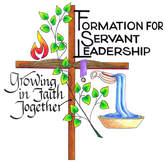
- Ministry Formation Skills Workshops - The Diocese of Scranton's Office for Parish Life offers four skills workshops/year for adults on a wide variety of ministry-related topics
- Certificate in Adult Formation Leadership - online program offered by the VLCFF at the University of Dayton and consisting of 7 courses:
- Foundations and Vision of Adult Learning and Faith Formation
- Parish as Learning Community
- Many Faces of Adult Learners
- Facilitating Adult Learning and Faith Formation
- Leadership Roles and Skills for Adult Learning and Faith Formation
- Spirituality in Adult Learning and Faith Formation
- Designing and Implementing Adult Learning and Faith Formation
